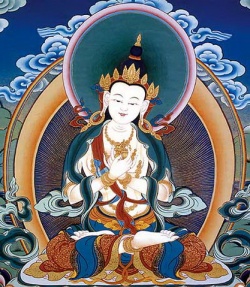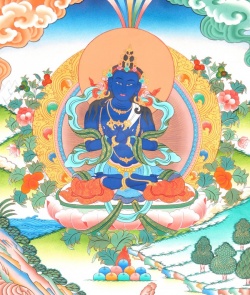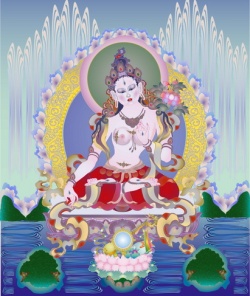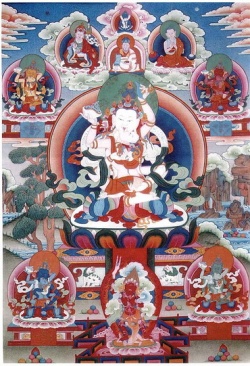Buddhist Gods and Goddesses
In addition to following the teachings of Buddha, most Buddhists also recognize various gods and demons, many of which take on different forms. Many Buddhist also recognize Hindu gods, Taoist gods, local deities partly out of respect and partly so as not to offend them. Belief in these gods somewhat goes against Buddha’s teachings. The Buddha did not claim to be of divine origin nor did he claim revelations from heaven or meditate or pray a higher being.
The Buddhist pantheon of gods is derived mainly from Hinduism, Indian folk religions, and local religions where Buddhism took root. In many cases characteristics of gods from different faiths are merged into a single god. A Buddhist god, for example, may have been derived from Hindu god and given characteristics of a local spirit. Moreover, the gods are intended to show the many sides of enlightenment: it has wrathful, vengeful sides as well as its peaceful and beneficent side.
Gods, angels, or celestial beings are sometimes referred to as devas , derived from the old Sanskrit div , meaning brightness. Hindus use the word to describe their gods. For Buddhists, describing devas as gods is not completely accurate. They are seen more as beings that are neither human or animal but are regarded as above human. All devas were humans at one time and may become humans again.
In many cases the worship of spirit and gods is seen as kind of an every matter, incorporating animist beliefs that predate the emergence of Buddhism. One Burmese man told National Geographic, "Buddhism is concerned with the hereafter; we placate and propitiate the nats in this world."
The Buddha himself had little to say about god. His message was about enduring the suffering in the world if they put a lid on their desires bot seeking salvation in the afterlife.
Websites and Resources: Buddha Net buddhanet.net/e-learning/basic-guide ; Victoria and Albert Museum vam.ac.uk/collections/asia/asia_features/buddhism/index ; Religious Tolerance Page religioustolerance.org/buddhism ; Wikipedia article Wikipedia ; Internet Sacred Texts Archive sacred-texts.com/bud/index ; Introduction to Buddhism webspace.ship.edu/cgboer/buddhaintro ;
Books: Buddhism by Christmas Humphrey (Pelican); Buddhism Explained by Phra Khantipalo; Buddhist Dictionary by Mahathera Nyanatiloka; Siddhartha by Herman Hesse. Also recommended are books by the Dalai Lama, Robert Thurman, a respected Buddhist scholar and former Tibetan Buddhist monk; and Thich Nhat Hanh, a Buddhist monk from Vietnam who has been involved with various anti-war activities. Film: Little Buddha
Websites and Resources on Buddhist Art: buddhism.org/board/main.cgi?board=BuddhistArt ; Buddhist Images buddhistimages.co.uk ; Religion Facts Images religionfacts.com/buddhism/gallery ; Buddhist Symbols viewonbuddhism.org/general_symbols_buddhism ; Buddhist Artwork buddhanet.net/budart/index ; Buddhism Images freewebs.com/buddhaimages ; Wikipedia article on Buddhist Art Wikipedia ; Buddha Images http://www.buddha-images.com/ ; Buddhist Art artlex.com/ArtLex/b/Buddhism ; Huntington Archives Buddhist Art kaladarshan.arts.ohio-state.edu ; Buddhist Art Resources academicinfo.net/buddhismart
No Buddhist Creator Gods
Buddhists do not believe in God as a creator and sustainer of the universe. The Buddha once said that the notion of a single Creator God began as a rumor invented by Brahma, one of the three most important Hindu gods.
"Now there comes a time when this world begins to evolve, and then the World of Brahma appears, but is empty." Buddha said, "And some being, whether because his allotted span is past or because his merit is exhausted, quits his body in the world of Radiance and is born in the empty World of Brahma, where he dwells for a long time. Now, because he has been so long alone he begins to feel dissatisfaction and longing, and he wishes that other beings might come and live with him. And indeed soon other beings quit their bodies in the World of Radiance to keep him company in the World of Brahma."
"Then the being who was first born thinks: "I am Brahma, the mighty Brahma, the Conqueror, the Unconquered, the All-seeing, the Lord, the Maker, the Creator, the Supreme Chief, the Disposer, the Controller, the Father of all that is or is to be. I have created all these beings, for I merely wished that they might be and they have come here! And the other beings...think the same, because he was born first and they later."
Buddhist Gods
Guanyin There are hundreds of gods in the Buddhist pantheon. Many have been borrowed from the Hindu pantheon to serve a particular purpose in Buddhist cosmology. Some have a humanlike appearance. Others look like monsters. Many have multiple arms and heads and hold various objects and display certain body positions and hand gestures that have symbolic meaning. At temples some serve as guardians and protectors at the entrance gates. Images found in temples vary according to sect and the period in which the temple was constructed. Gods, goddesses, and other celestial being tend to play a bigger role in Mahayana Buddhism than Theravada Buddhism. Mahayana Buddhism introduced a number of female deities.
Buddhist gods include Avalokitesvara (the eleven-headed God of Mercy), Panchika (god of riches), Harati (goddess) of fertility), Garuda (mythical bird), Yakshas and Yakshhis (male and female spirits associated with fertility), nagas (mythical serpent gods), Kinaras, or gandharvas (celestial musicians), Guanyin (Buddhist-Taoist goddess of Mercy), asparas (angels) dharmpalas (demonlike creatures that stomp on human bodies). Some have been adapted from the Hindu pantheon. Some have been taken outright from the Hindu pantheon.
As is true with Hindu gods many Buddhist gods have different manifestations. Avalokitesvara appears in 33 different manifestations. One reason for this is that locals were absorbed into the Buddhist pantheon by making them manifestations of existing Buddhist gods.
Naga, the serpent king, protected Buddha when he sat under bodhi tree before his enlightenment Kshitigarbha, Lord of the Netherworld, holds a staff and looks after the welfare of the dead Samantabhadra dispenses talismaic formulas which avert dangers and is often depicted riding on a white elephant.
Avalokitesvara
Avalokiteshvara Avalokitesvara (meaning “Lord Who Looks Down”) is arguably the most common and popular Buddhist celestial being. Regarded as a god, a goddess and a Bodhisattva and featured prominently in the Lotus Sutra, he is closely associated with Amitabha and lives between births in Amitabha’s Western paradise.
Avalokitesvara has a number of body parts and objects with symbolic meaning. Of his 11 heads, the central head one at the top belongs to Amitabha. He often has multiple arms, sometimes more than a thousand of them. The central pair of hands is in the cupped position representing respect. In one hand he hold a lotus, symbolizing enlightenment, In another he holds a bow and arrow, symbolizing a Bodhisattva’s ability to get at the heart of the matter.
Avalokitesvara appears in 33 different manifestations and 108 forms, including the goddess of mercy, popular with pregnant mothers and invoked by people in trouble. Simply repeating her name several times is considered enough to drive away evil.
Harati
Hariti was a fearsome female demon that originated in India and had more than 500 children that she loved dearly. To satisfy her hunger, however, she hunted children of local people who sought the Buddha for help. Buddha kidnapped and hid Hariti’s youngest and most beloved child. The demon was filled with despair. Realizing the pain she caused other, she vowed never to hunt children again and was so repentant that she became a special protector for children and mothers. In return Buddha taught to her to satisfy her hunger with pomegranate seeds.
Like many Indian deities, Hariti was adopted into the Buddhist pantheon that was later transmitted to China and from there to Japan, where she his now known as Kishimoji or Kishibojin, a popular god with women who want children and expecting mother who want a safe and easy birth. The deity also looks after the health and safety of young children. Pomegranate trees are often planted at temples that honor her.
Tibetan Buddhist Gods
Vajradhara The pantheon of gods in Tibetan Buddhism is derived mainly from Hinduism, Indian Buddhism and the Bon religion. In many cases characteristics of gods from all three faiths are merged into a single god. A Buddhist god, for example, may have been derived from Hinduism and given characteristics of a Bon religion spirit. Moreover, the gods are intended to show the many sides of enlightenment: a particular god may have a wrathful, vengeful side as well as a peaceful and beneficent side.
Himalayan Buddhists recognize several thousand gods and demons, many of which, like their Hindu counterparts, take on many forms. Each village and sect has its own pantheon of gods, spirits and demons. Rivalries between different groups and sects are often based on which gods are given the greatest importance. Many monasteries contain Tara figures that are said to have miraculously materialized out of thin air.
There are many general protector gods called "dharmapalas" and personal meditation deities called "yidams" (which can either be male herakas or female dakinis). Protector deities have both wrathful and benign manifestations. Their expression of rage or passion pack a great amount of energy. High mountains are believed to be dwelling places for a number of gods. Tibetans shout "Victory to the gods" as a greeting to these deities when they are in mountains. Sometimes deities are pictured at the center of mandala representations of the worlds the inhabit.
A number of historical figures are treated with same reverence as gods. See Guru Rinpoche, Tsongkhapa, the 5th Dalai Lama. King Songtsen Gampo, King Trisong Detsen and Milarepa.
A typical deity such as Sambara has a consort, Vajravarahi, and an escort of 12 dakinis, deities who represent female wisdom. Demons are believed to be responsible for a number of ills and misfortunes. The Mustangese recognize 416 demons of land, sky, fire and water. These demons are believed to cause 1,080 known diseases and five forms of violent death.
Dipamkara Buddhists tend to look upon gods in a different way than Westerners. Tibetan gods, one religious scholar wrote, represent "mental states evoked in meditation and ritual, a means of training the mind toward a more accurate appreciation of the human condition."
Buddhist Gods in Japan
Japanese Tempe Guardian Many gods in Japan have both non-Japanese origins. Hotei, one of the seven gods of good luck, is the god of happiness. A common symbol throughout Asia, he is jolly fellow with a big grin, pot belly and a bag sack. His ancestors can be traced back to a real human being, a Chinese monk associated with the Chinese sect that gave birth to Zen Buddhism. Hotei is a bit like a year-round Santa Claus, traveling around the countryside with his sack, giving food and necessities to the poor and needy and giving out presents to those who deserve them. Benzaiten, another one of the seven gods of good luck, is the goddess of art. Wise and skilled in painting and writing, she carries a biwa (mandolin) and is often escorted by a sea snake. Originally a spirit of flowing water with her roots in India, she is the patron saint of musicians and performers. Shrines for her with images of snakes are often set up near ponds.
Bishamon is the god of war and the protector of Buddhism, scared mountains, temples and cities. Usually depicted with a helmet, suit of armor and spear, he was originally a folk god in India and was adopted by Buddhism. He is often found at the north gate or entrance of a building and is skilled at turning away evil spirits that cause poverty and bring bad luck.
Important gods and Bodhisattvas in Japan include Kannon, the 1,000-armed, 11-faced goddess of mercy; Jizo (often portrayed with children in his arms), a Bodhisattva who helps children and travelers; Fudo Myoo, a protector against danger and king of wisdom; Yakushi (Bhaisajaguru), the healer of the mind and body; and Amida (literally meaning “infinite light” or “infinite life”), the Buddha of the Western Paradise.
Bato Kannon, Horsehead Kannon, is a manifestation of Kannon often depicted in small stone statues of Kannon with a horse popping out of her hair or headdress. She specializes in caring for the souls of animals and other nonhuman creatures. The god of thunder is portrayed as a snake.
Jizo is a patron for travelers and children. He helps children build walls in the underworld and is associated in Japan with helping aborted fetuses and children who died young. According to tradition, Jizo was an Indian monk who became a Bodhisattva. In India he was known by a different name. There is no evidence that he ever had a large following there. In China he gained a reputation for being compassionate and helping people to avoid reincarnation as terrible beasts.
Jizo didn’t develop a large following until he arrived in Japan. His association with rescuing people from unfortunate births was focused on children who died in the hope that they would have good afterlives. Jizo developed a particularly large following among women, who placed statues of him along roadsides and in Buddhist temples. Over time statues of Jizo changed from large ones of a dignified man to small ones of childlike man with a bald head. When abortions became commonplace in Japan places on hillsides were set aside for thousands of jizo statues.
Jizo statues are often found in groups of six, each with their hands in a different mudra (position) and each linked to relieving the pain of residents of the six realms of Buddhist cosmology: 1) one holds his hands in a praying position next to his chest and is associated with the Amida Buddha and the realm of humans: 2) one holds a sacred jewel and holds his hand in the no fear mudra and is associated with deva living on Mt. Sumisen; 3) one holds a set of Buddhist rosary beads and is associated with the realm of the non-human creatures; 4) one holds a sacred jewel and a pilgrims staff and is associated with Ashura, the realm of the deities; 5) one holds an incense banner and is associated with hell; and 6) the last one holds an incense censer and is associated with the realm of the hungry spirits. The six statues are grouped to together because the people who placed them there may not know where their deceased loves ones are and thus say prayers to the entire universe and all realms to reach them.
Tibetan Protector Deities
Mahakala Guardian King Dhritarastra Chokyoing (Lokpalas) are the Four Guardian Kings. Often found at the entrance hallway of monasteries and believed to be Mongolian in origin, they protect the four cardinal directions. The eastern king is white and carries a lute. The southern king is blue and carries a sword. The western king is red and carries a thunderbolt. The northern king is yellow and carries a banner of victory and a jewel-spitting mongoose. He is regarded as the god of wealth and is depicted riding a snow lion.
Dorje Jigje (Yamantaka) is the most well-known protector of the Yellow Hat sect. Known as the destroyer of Yama, the Lord of Death, he is a blue, beastly-looking creature with eight heads, one of which is the head of a bull, and strings of skulls around his waist and neck. He holds a flaying knife and a skull cup in his eight to 36 arms. With his 16 feet he stomps on eight Hindu gods, eight mammals and eight birds. Dorje Jigje punishes evil people to a life in hell, helps guide good people to a better rebirth and crushes earthly passions that block enlightenment. Yamanataka is so horrible that no one should look at his image, especially women. Statues of him are often covered.
Yamantaka Nagpo Chenpo (Mahakala) is wrathful Tantric god and a manifestation of Chenresig (Avalokiteshvara). Associated with the Hindu god Shiva, he is blue and has fanged teeth, a crown fo skulls, and carries a trident and skull cup. He comes in various forms, with two to six arms and is regarded as the protector of tents by nomads. Nangpo Chenpo means the Great Black One .
Tamdrin (Hahagriva) is another wrathful manifestation of Chenresig (Avalokiteshvara). Associated with the Hindu god Vishnu, he is red with a white face on the right and green gace on the left and has a horse’s head in his hair, a crown of skulls, a tiger skin around his waist and a garland of 52 chopped off heads. On his back are the wings of Garuda. In his six hands are a lotus, club sword, skull cup, snare and ax. Under his four legs a sun disc and corpses. Tandrin in red and Dorje in blue often serve as guardian gods at the entrance of temples.
More Tibetan Buddhist Protector Deities
Mahakala Chan Dorje (Vajrapani) is the wrathful Bodhisattva of Energy. He is blue with a tiger skin around his waist and snake around his neck. In his right hand is a thunderbolt, the symbol of the Tantric faith. Chan Dorje means “thunderbolt in hand.”
Demchok (Chakrasamvara) is a meditational deity with a blue body, 12 arms, four faces, and a crescent moon in his topnot. In his hands are a thunderbolt, a bell, a elephant skin, an axe, a hooked knife, a trident, a skull, a hand drum, a skull cup, a lasso and head of Brahma. He wears a tiger skin and has a garland with 52 severed heads around his neck.
Palden Lhamo (Shri devi) is the guardian of Lhasa, the Dalai Lama an the Yellow Hat sect. An angry manifestation of Tara The female counterpart of Nagpo Chenpo (Mahakala), she is blue, wears tiger skin and human skin clothes and has earrings made of a snake and a lion and carries a skull cup full of blood in her left hand and a club in her right hand. A moon is in her hair; the sun is her stomach; and a corpse is in her mouth.
Image Sources: Wikimedia Commons, Ray Kinnane, Simhe
Text Sources: World Religions edited by Geoffrey Parrinder (Facts on File Publications, New York); Encyclopedia of the World’s Religions edited by R.C. Zaehner (Barnes & Noble Books, 1959); Encyclopedia of the World Cultures edited by David Levinson (G.K. Hall & Company, New York, 1994); The Creators by Daniel Boorstin National Geographic articles. Also the New York Times, Washington Post, Los Angeles Times, Smithsonian magazine, Times of London, The New Yorker, Time, Newsweek, Reuters, AP, AFP, Lonely Planet Guides, Compton’s Encyclopedia and various books and other publications.




